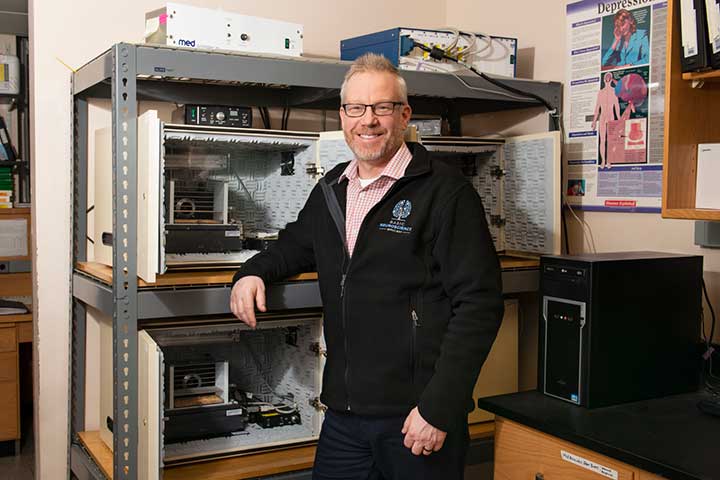2023 marks Bill’s 25th anniversary at McLean Hospital—his first postdoc job as independent faculty after graduating from Yale in 1998. A native of Needham, MA, Bill grew up aware of McLean but hadn’t grasped its international reputation until his first visit in 1996. “As soon as I stepped foot on campus for a collaborative project internship, I could imagine myself there; I was impressed by the facilities and the people. It’s a place that matched what I wanted to do, what I wanted to study, what I wanted to accomplish, and what I lacked to succeed.”
Before arriving at McLean, Bill had been researching stress, depression, and mental health conditions without really knowing how they looked in people. “Being exposed to psychiatrists who are studying and treating mental health disorders in people who have these conditions, which up until that point I had only read about, was a game changer. I had been working in settings where most of us specialized in molecular biology or animal models in labs and we had no access to psychiatrists or their patients, even though we were trying to study depression and PTSD. Speaking with psychiatrists and understanding the people side of the equation elevated my work to another level.”
2023 also marks a significant milestone in Bill’s storied career at McLean as Chief of the Rappaport Center of Excellence in Basic Neuroscience Research and the inaugural Rappaport Chair in Psychiatry. “One of the Rappaport Center’s overarching missions is to promote the alignment of psychiatry and neuroscience. We’re getting people from these two traditionally separate domains to talk to one another so they can understand the language and terminologies each uses. We hope this dialog improves our understanding of the brain and how it works both when it’s healthy and when it’s not.”
Another mission of the Center is to improve the usefulness of animal models. “Many drugs look promising in animal models but fail to be effective once they get into humans. This is because animal models often use different endpoints than we use in people. But if we develop better animal models and give animals experimental therapeutics and the experimental therapeutic works, we can be more confident it will work in a person.”
Under Bill’s tutelage, McLean’s Rappaport Center will invest in focusing on three primary areas of research: the use of digital endpoints across species, phenotyping, and the study of the long-term effects of early-life trauma, which can include experiences ranging from illness to bullying to growing up in impoverished environments.
“Digital phenotyping uses smartphones and smartwatches to diagnose and treat people with mental health conditions; this is gradually taking over psychiatry. Before the pandemic, no one was sure how this would look or even if it could work. Frankly, there was some concern that these devices would replace psychiatrists or therapists, but the pandemic forced us to use these devices, and it’s become clear that they can significantly enhance what a psychiatrist or a therapist can do. So the question for us becomes, how do we use them to advance psychiatry and neuroscience research? We’ve all seen ads for smartwatches that tout all the measurements and metrics they’re sensitive to, including heart rate, body temperature, and sleep patterns. We’re gradually paying more attention to these measurements and how they’re changed by stress or adversity, and we are now using the same endpoints in our animal models. Sleep is the most obvious one because it is measured and defined in the same way in a human and a mouse, and we are all intuitively familiar with how disruptive even a night or two of poor sleep can be.”
Bill is also researching how what happens early in life affects people’s mental health in adulthood. “We’re seeing evidence that things that happen early in life can set people on a trajectory toward both poor physical health and mental health issues. So, we’re starting to look at what’s going on early in life in much more detail. We’re using several models; one is a bullying model where a smaller mouse lives under constant threat from a larger, older, and meaner mouse. The larger animal wrestles and dominates the smaller animal. We do this over a period of time, usually a week or so, and then stop that interaction. The mouse that was repeatedly dominated when it was young shows profound depression-like signs, including abnormal sleep patterns. It’s also not sensitive to things that normal, healthy animals would find rewarding. These animals show signs of anhedonia, a reduced ability to experience pleasure, which is a hallmark sign of depressive conditions.”
Another modality Bill studies is the austerity model, where young mice live in less-than-ideal circumstances. “The mouse family lives in impoverished conditions. Typically, the environment has limited adequate nesting materials, which creates a stressful environment for the mother and her offspring. As was the case in the bullying model, living in these austere conditions early in life can have long-lasting effects across the lifespan of the offspring. Even though both models involve early life stressors, with one involving aggression and the other involving limited resources where the mom is trying hard to nurture the offspring—to keep them safe, warm, and comfortable, but because of the resources available, it’s just not possible. We recognize that these situations happen separately or in combination with people in real-life situations. And we’re trying to recreate and model these types of situations, things happening in real life in our animal models, with the hope that better animal models will allow us to more accurately predict what will happen in humans more effectively.”
Bill is also studying whether Ketamine, a promising new drug to treat depression in humans, can reverse any of the symptoms of these early life stressors. “We’re looking closely at Ketamine, which has been in the news recently because a single treatment can produce immediate antidepressant effects that last for a long time. Not long ago, if someone were to arrive at McLean with clinical depression, they’d be given standard antidepressant drugs, which are not likely to work right away. Even if the drugs eventually work, they usually take 4 to 6 weeks to become effective. Many of these drugs actually promote anxiety at first, so there is often a period of time during which the person feels worse before they feel better. Ketamine is such a revelation because it shows that it is possible for people to feel better immediately. This has changed our understanding of what needs to happen in the brain to treat depression. The other revelation is that you can get these long-lasting effects from Ketamine even with a single treatment instead of taking medications every day, for a lifetime.”




